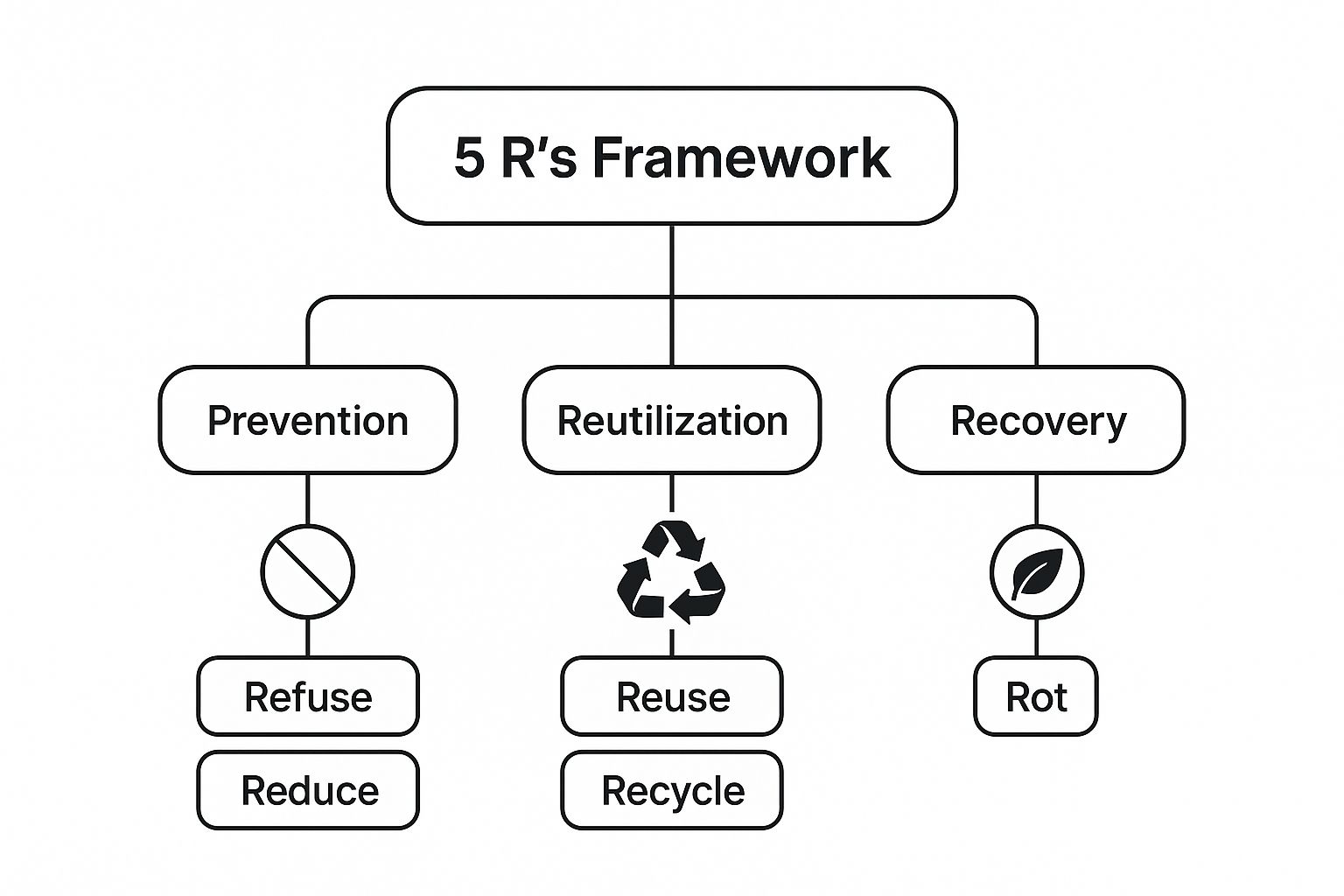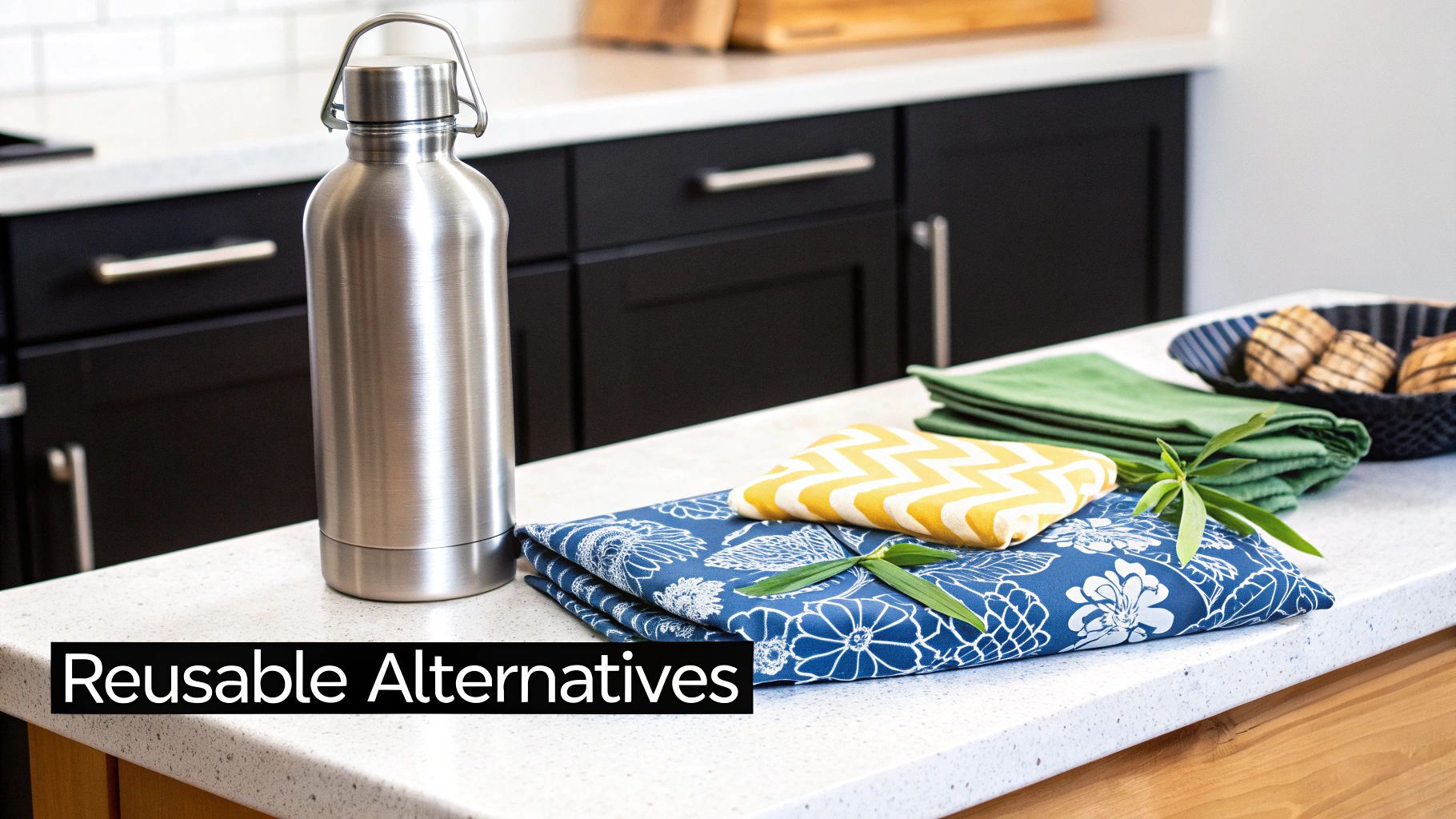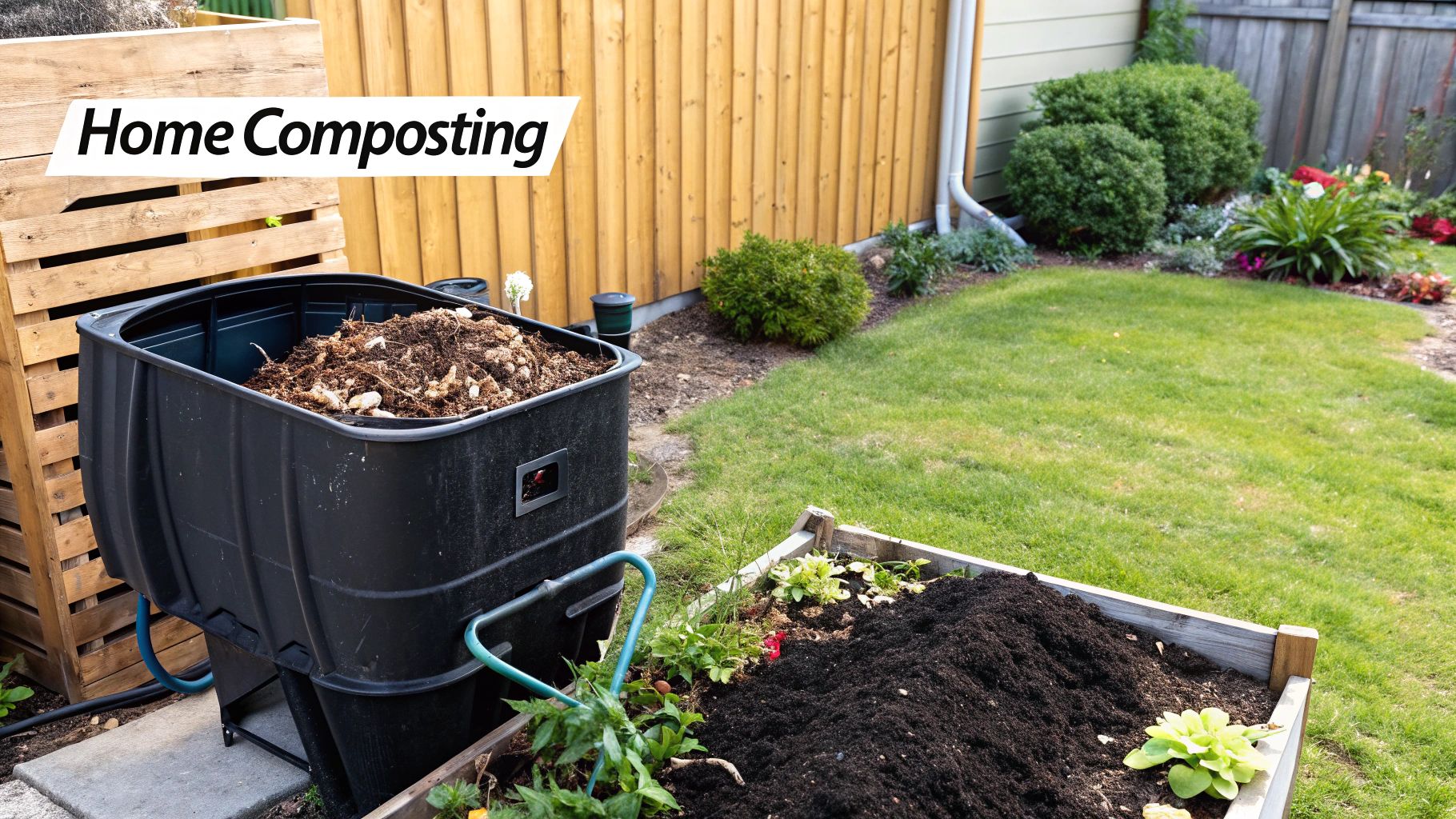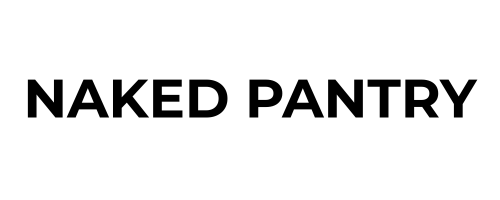
8 Essential Zero Waste Lifestyle Tips for 2025
Share
The concept of a 'zero waste' life can feel intimidating, often conjuring images of a single mason jar holding years of trash. While admirable, the true power of the zero waste movement lies not in perfection, but in progress. It is about making conscious, incremental changes that collectively reduce our environmental footprint and redefine our relationship with consumption. This guide moves beyond the basics of recycling, offering eight comprehensive and actionable zero waste lifestyle tips designed for real-world application.
Forget overwhelming ideals. Instead, focus on tangible steps you can take today. We will explore foundational frameworks like the 5 R's, practical kitchen swaps, and community-building strategies that empower you to significantly cut down on what you send to the landfill. By implementing these strategies, you can reduce your exposure to chemicals often found in disposable plastics and adopt a more sustainable way of living. Each tip presented here is a practical building block, allowing you to create a personalized approach that fits your specific circumstances and long-term goals. Let's begin building a lower-waste life, one intentional choice at a time.
1. Adopt the 5 R's Framework
Before diving into specific swaps and habits, the most impactful first step is to adopt a foundational mindset. The 5 R’s framework (Refuse, Reduce, Reuse, Recycle, Rot) provides a clear, prioritized roadmap for a zero waste lifestyle. Popularized by pioneers like Bea Johnson and Kathryn Kellogg, this system isn't just a list; it's a hierarchy that guides your decision-making, emphasizing prevention above all else.
This approach is one of the most effective zero waste lifestyle tips because it moves beyond just recycling and composting. It forces you to address consumption at its source, which has a far greater environmental impact.
How the 5 R's Hierarchy Works
The power of this framework lies in its order of operations. You should always try to apply the R's from top to bottom, moving to the next level only when the previous one isn't possible.
- Refuse: The first and most important step is to say no to things you don't need. This includes single-use plastics like straws and bags, promotional freebies, and junk mail.
- Reduce: For items you can't refuse, focus on reducing your consumption. This means buying less, choosing items with minimal packaging, and being mindful of what you truly need versus what you want.
- Reuse: Before you recycle or discard something, find a new purpose for it. This can mean refilling glass jars, using cloth towels instead of paper ones, and repairing broken items instead of replacing them.
- Recycle: This is a crucial step for materials that can't be refused, reduced, or reused. It's important to understand your local recycling guidelines to do it correctly.
- Rot: The final R applies to organic matter. Composting food scraps, coffee grounds, and yard trimmings turns waste into valuable nutrients for the soil.
The infographic below illustrates the hierarchical structure of the 5 R's, grouping them into stages of prevention, reutilization, and recovery.

As the diagram shows, the primary focus is on Prevention (Refuse, Reduce), as these actions stop waste from ever being created.
2. Transition to Reusable Alternatives
Once you’ve embraced the 5 R’s, the next practical step is to replace single-use items with durable, reusable alternatives. This strategy directly applies the "Reuse" principle by identifying the disposable products in your daily routine and systematically swapping them for sustainable versions that can be used hundreds, or even thousands, of times.
This approach is one of the most visible and empowering zero waste lifestyle tips because it creates tangible, everyday change. Pioneers like Lauren Singer of Trash is for Tossers and retailers like Package Free Shop have popularized this by showing how simple swaps can dramatically reduce personal waste.

How to Make the Switch to Reusables
The key to a successful transition is to be methodical and start small. Focus on the items you use and discard most frequently to see the biggest impact first.
- In the Kitchen: Replace plastic wrap with beeswax wraps or silicone lids. Swap paper towels for cloth napkins and unpaper towels. Use reusable silicone bags from brands like Stasher instead of disposable plastic baggies.
- On the Go: A reusable water bottle is a classic first swap. Also consider a reusable coffee cup, metal or bamboo utensils, and a cloth napkin to create a "zero waste kit" for meals outside the home.
- In the Bathroom: Switch from a plastic toothbrush to a bamboo one. Consider safety razors instead of disposable ones, and explore reusable menstrual products like cups or fabric pads.
- For Shopping: Always bring your own reusable tote bags for groceries and cloth produce bags for loose fruits and vegetables.
A crucial tip is to only replace disposables once you've used them up. Throwing away a full roll of paper towels to buy cloth ones is counterproductive. The goal is to prevent future waste, not create more in the process.
3. Embrace Bulk Shopping and Refill Systems
A significant portion of household waste comes from food and product packaging. Embracing bulk shopping and refill systems is a direct-action strategy that tackles this problem at the source. This approach involves purchasing goods, from pantry staples to cleaning supplies, without their single-use containers by using your own reusable jars, bags, and bottles.
This method is one of the most effective zero waste lifestyle tips because it not only eliminates packaging waste but often leads to cost savings and reduced food waste. You have the freedom to buy the exact quantity you need, whether it's a teaspoon of a rare spice or ten pounds of flour.

How to Get Started with Bulk and Refill Shopping
Transitioning to package-free shopping is a gradual process. You don't need to buy everything in bulk overnight. Start with a few items and build from there. Many grocery stores, co-ops, and even farmers markets now offer bulk options.
- Gather Your Containers: Start by saving glass jars from pasta sauce, pickles, and jams. Cloth produce bags and silicone bags are also excellent for lighter items. You don't need to buy a fancy new set of containers to begin.
- Know Your Tare Weight: Before you fill your containers, they need to be weighed. This is called the "tare weight." Most stores have a scale at the front or at a customer service desk where you can weigh your empty container and write the weight on it. This ensures you only pay for the product inside.
- Start with Easy Items: Non-perishables are a great starting point. Focus on dry goods like rice, pasta, beans, lentils, oats, nuts, and spices. These are easy to store and have a long shelf life.
- Explore Beyond Food: Bulk shopping isn't limited to the pantry. Many zero waste stores and co-ops, like those pioneered by retailers such as Rainbow Grocery, offer refill stations for liquid goods like shampoo, conditioner, laundry detergent, dish soap, and olive oil.
4. Master Home Composting
Diverting food scraps from the landfill is one of the most impactful zero waste lifestyle tips you can adopt. Composting transforms organic waste like fruit peels and coffee grounds into a nutrient-rich soil amendment, preventing it from producing methane in landfills. This natural decomposition process closes the loop on your food system, turning what was once trash into a valuable resource for your garden or houseplants.
This approach is highly effective because an estimated 30% of household waste is organic matter that can be composted. By managing this at home, you take direct responsibility for a significant portion of your waste stream, reducing your reliance on municipal systems and creating a valuable byproduct.

How to Get Started with Composting
Composting can seem intimidating, but there are accessible methods for every living situation, from large backyards to small apartments. The key is finding a system that fits your space and lifestyle.
- Outdoor Bins or Piles: Ideal for those with yard space. A simple pile or a purchased bin allows you to compost yard trimmings alongside kitchen scraps.
- Tumbler Composters: These sealed, rotating barrels speed up decomposition and keep pests out, making them a cleaner and faster option for suburban homes.
- Worm Composting (Vermicomposting): A perfect solution for apartments and small spaces. A worm bin can be kept indoors or on a balcony and efficiently breaks down food scraps with minimal odor.
- Bokashi Fermentation: This indoor system uses specific microorganisms to pre-compost all food waste, including meat and dairy. The resulting material can then be buried in soil.
When composting, you're not just reducing waste; you're creating valuable resources. You can learn how to crear abono orgánico para tus plantas, turning kitchen scraps into nutrient-rich soil. This final product, often called "black gold," enriches your garden, improves soil structure, and reduces the need for chemical fertilizers, completing a beautiful, sustainable cycle.
5. Implement Mindful Consumption Practices
Beyond just swapping products, a core tenet of a zero waste lifestyle is shifting your entire approach to acquiring new things. Mindful consumption is the practice of making conscious, intentional decisions about every purchase. It involves pausing to consider an item's necessity, longevity, and overall environmental impact before you buy, effectively breaking the cycle of overconsumption that fuels waste.
This approach is one of the most powerful zero waste lifestyle tips because it addresses the root cause of waste: buying too much stuff. By prioritizing quality over quantity and need over want, you naturally reduce your demand for new products, which in turn reduces manufacturing, packaging, and shipping emissions.
How to Practice Mindful Consumption
The goal of mindful consumption is to move from reactive, impulse buying to a more deliberate and value-driven process. To truly implement it, consider embracing a minimalist approach by reducing excess possessions. Learn some smart downsizing tips that can help clear out clutter and reset your relationship with material goods.
- Implement a Waiting Period: For any non-essential purchase, enforce a 24 to 48-hour waiting period. This simple delay helps distinguish fleeting wants from genuine needs.
- Invest in Longevity: Instead of cheap, disposable alternatives, choose high-quality items designed to last for years, or even decades. Calculate the "cost-per-use" to see the long-term value.
- Choose Experiences Over Things: Often, memories from an experience like a concert, a trip, or a class provide more lasting fulfillment than a material object.
- Research Brand Ethics: Before buying, take a moment to research the company's environmental and ethical practices. Support businesses that align with your values.
- Shop Your Home First: Before running to the store, check if you already own something that could serve the same purpose. This simple habit prevents redundant purchases and sparks creativity.
6. Create DIY Household and Personal Care Products
Transitioning to a zero waste lifestyle involves scrutinizing the products we bring into our homes, many of which come in single-use packaging and contain harsh chemicals. Creating your own household and personal care products is a powerful strategy to eliminate this waste at the source while gaining full control over the ingredients you use on your body and in your home. This approach directly tackles packaging waste and reduces reliance on complex, often unpronounceable, chemical formulations.
This practice is one of the most empowering zero waste lifestyle tips because it fosters self-sufficiency and deepens your connection to the items you consume. Instead of buying a new plastic bottle every time you run out of cleaner or deodorant, you simply refill your reusable container with a homemade, all-natural alternative.
How to Get Started with DIY Products
The key to successful DIY is starting simple. You don't need a lab full of exotic ingredients; many effective recipes use common pantry staples like baking soda, vinegar, and coconut oil.
- All-Purpose Cleaner: A simple mixture of equal parts white vinegar and water in a spray bottle can clean most surfaces. Add a few drops of an essential oil like lemon or tea tree for a pleasant scent and extra antibacterial properties.
- Soft Scrub: For tougher jobs in sinks and tubs, make a paste with baking soda and a small amount of liquid castile soap. It provides gentle abrasion without scratching surfaces.
- Simple Deodorant: A basic, effective deodorant can be made by mixing equal parts arrowroot powder (or cornstarch) and baking soda with enough melted coconut oil to form a paste.
- Toothpaste or Tooth Powder: Mix baking soda with a small amount of coconut oil for a simple toothpaste. For a powder, just use baking soda, optionally adding a drop of peppermint essential oil.
Embracing DIY solutions often means finding new purposes for everyday items. For instance, you might be surprised by the unexpected uses for olive oil beyond the kitchen, including in homemade personal care and cleaning products. The goal is to use versatile, multi-purpose ingredients to replace a cabinet full of single-use products.
7. Develop Repair and Upcycling Skills
In a world dominated by disposable goods, reclaiming the power to fix and transform what you own is a revolutionary act. Developing repair and upcycling skills directly confronts throwaway culture, extending the life of your possessions and preventing them from prematurely ending up in a landfill. This hands-on approach embodies the "Reuse" principle of the 5 R's framework at its most creative level.
This strategy is one of the most empowering zero waste lifestyle tips because it shifts your role from a passive consumer to an active creator. Instead of seeing a torn shirt or a wobbly chair as trash, you begin to see it as an opportunity. This mindset, popularized by movements like the Repair Cafe and creative communities online, fosters resourcefulness and saves you a significant amount of money.
How to Integrate Repair and Upcycling
Adopting this skill set means choosing to invest a little time and effort to preserve an item rather than immediately replacing it. The goal is to build confidence in your ability to maintain and reimagine your belongings.
- Repair: This is the first line of defense against waste. It involves mending, fixing, and restoring items to their original function. Learning basic sewing to patch a hole, or how to use a screwdriver to tighten a loose handle, can make a huge difference. For more complex fixes, resources like iFixit provide free, detailed guides for electronics.
- Upcycle: When an item cannot be repaired or is no longer needed in its original form, upcycling gives it a new, often higher-value purpose. This is where creativity truly shines. An old t-shirt can become a reusable tote bag, a glass pasta sauce jar transforms into a stylish spice container, and a worn-out wooden ladder can be repurposed as a unique bookshelf.
Embracing repair and upcycling isn't about becoming a master craftsperson overnight. It's about starting small, learning as you go, and appreciating the value embedded in the things you already own, preventing waste one project at a time.
8. Build a Zero Waste Community Network
While individual actions are powerful, building a community network amplifies your impact and provides crucial support. A zero waste community connects you with like-minded people and organizations, creating a system for sharing resources, knowledge, and motivation. Initiatives like the Buy Nothing Project and local repair cafes show how collective effort can dramatically reduce waste and strengthen local resilience.
This approach is one of the most sustainable zero waste lifestyle tips because it tackles isolation and consumerism head-on. It creates a circular economy on a local level, making it easier to refuse, reduce, and reuse by tapping into a shared pool of items and skills. Instead of buying new, you can borrow, swap, or learn to fix what you already have.
How a Zero Waste Network Works
Building a community network involves actively seeking out and participating in groups that align with low-waste values. These connections create opportunities to give and receive items, skills, and support, making a sustainable lifestyle more accessible and enjoyable.
- Share and Borrow: Platforms like local Buy Nothing groups allow neighbors to freely give away items they no longer need and request things they are looking for, preventing perfectly good items from ending up in a landfill.
- Skill Swapping: Community repair cafes or workshops bring people together to fix broken electronics, mend clothing, and repair furniture, teaching valuable skills and extending the life of products.
- Bulk Resources: Community gardens often have shared composting programs, allowing members who lack space to compost their food scraps. Some communities also organize bulk buying clubs to reduce packaging.
- Information Exchange: Online forums, such as local Zero Waste Facebook groups, are invaluable for asking questions, sharing successes, and learning about regional recycling rules or where to find package-free goods.
By participating, you not only reduce your personal waste but also contribute to a culture of conscious consumption. These networks provide the practical support needed to turn individual intention into collective, impactful action.
Zero Waste Lifestyle Tips Comparison
| Strategy | Implementation Complexity 🔄 | Resource Requirements ⚡ | Expected Outcomes 📊 | Ideal Use Cases 💡 | Key Advantages ⭐ |
|---|---|---|---|---|---|
| Adopt the 5 R's Framework | Moderate to High - requires lifestyle changes | Moderate - ongoing effort and mindfulness | High - deep waste reduction and cost saving | Comprehensive zero waste adoption at individual/community level | Clear framework addressing root causes |
| Transition to Reusable Alternatives | Low to Moderate - initial investment and habit building | Moderate - purchase of durable items | High - significant waste reduction over time | Replacing single-use disposables in daily routines | Long-term cost savings and quality improvement |
| Embrace Bulk Shopping and Refill Systems | Moderate - planning and container management | Low to Moderate - reusable containers and time | High - reduces packaging waste and overbuying | Shopping for pantry staples and household products | Cost-effective per unit, reduces packaging waste |
| Master Home Composting | Moderate - ongoing maintenance and monitoring | Low to Moderate - compost bin/tumbler and space | Moderate - waste diversion and soil enrichment | Organic waste management at home or community | Reduces landfill methane, creates fertilizer |
| Implement Mindful Consumption Practices | Moderate - behavioral and habit changes | Minimal - focus on intentional purchasing | High - reduced consumption and environmental impact | Conscious shoppers aiming to reduce overconsumption | Saves money, improves product longevity |
| Create DIY Household and Personal Care Products | Moderate to High - time and learning investment | Low to Moderate - ingredients and supplies | Moderate - less packaging waste and chemical exposure | Those seeking chemical-free, customizable alternatives | Cost-effective and customizable |
| Develop Repair and Upcycling Skills | Moderate to High - skill acquisition and tool needs | Low to Moderate - basic tools and workspace | Moderate to High - extended product lifespan | Repairing or repurposing household items | Saves money and reduces landfill waste |
| Build a Zero Waste Community Network | Moderate - time and social engagement required | Low - mostly time and communication tools | High - amplified collective impact | Individuals seeking support and resource sharing | Provides motivation, resources, and collective power |
Your Journey to a Plastic-Free Pantry and Beyond
Embarking on a zero-waste journey is not about achieving perfection overnight; it's about making a series of conscious, incremental changes that collectively forge a powerful, positive impact. As we've explored, the path to a low-impact lifestyle is built on a foundation of practical strategies, from adopting the 5 R's framework to mastering home composting and building a supportive community network. Each of these zero waste lifestyle tips serves as a vital tool in your sustainability toolkit, empowering you to reduce your environmental footprint one small step at a time.
Remember that this is a journey of continuous learning and adaptation. Some changes, like switching to reusable shopping bags or a stainless steel water bottle, might feel simple and immediate. Others, such as creating your own DIY household cleaners or developing repair skills, require more patience and practice. The key is to start where you are, with what you can manage, and build momentum from there. Don't be discouraged by occasional setbacks; they are a natural part of the process.
From Small Steps to Lasting Habits
The true power of these strategies lies in their cumulative effect. When you consistently practice mindful consumption, choose to repair what’s broken, and seek out package-free options, you are fundamentally shifting your relationship with the resources you use. This transition from a linear "take, make, dispose" mindset to a circular one is where real change happens.
The most important takeaway is that your individual actions matter. They create a ripple effect that influences manufacturers, retailers, and the people in your life. By prioritizing reusable alternatives and supporting businesses that champion refill systems, you are casting a vote for a more sustainable and equitable future. Your choices signal demand for better systems, pushing the market toward circularity and away from single-use dependency.
Where to Begin Your Transformation
For many, the most effective and rewarding starting point is the kitchen. Our pantries are often ground zero for single-use plastic, from pasta bags and cereal boxes to spice jars and snack packaging. Transforming this one area of your home can dramatically reduce your waste and simplify your life. Embracing bulk shopping is a cornerstone of this transformation, allowing you to buy exactly what you need without the unnecessary packaging.
This is where the true value of incorporating actionable zero waste lifestyle tips becomes clear. By focusing on high-impact areas like food sourcing, you not only eliminate significant amounts of plastic but also connect more deeply with the food you eat. It’s a holistic approach that benefits your health, your wallet, and the planet. Celebrate every plastic-free meal and every refillable container you use, as these small victories are the building blocks of a lasting, sustainable lifestyle.
Ready to revolutionize your pantry without the hassle? Start your journey with Naked Pantry. They deliver high-quality, organic, and non-GMO pantry staples directly to your door in 100% compostable and reusable packaging, making it one of the easiest and most impactful zero waste lifestyle tips you can implement today. Explore the plastic-free possibilities at Naked Pantry and take the first step towards a cleaner, healthier home.
